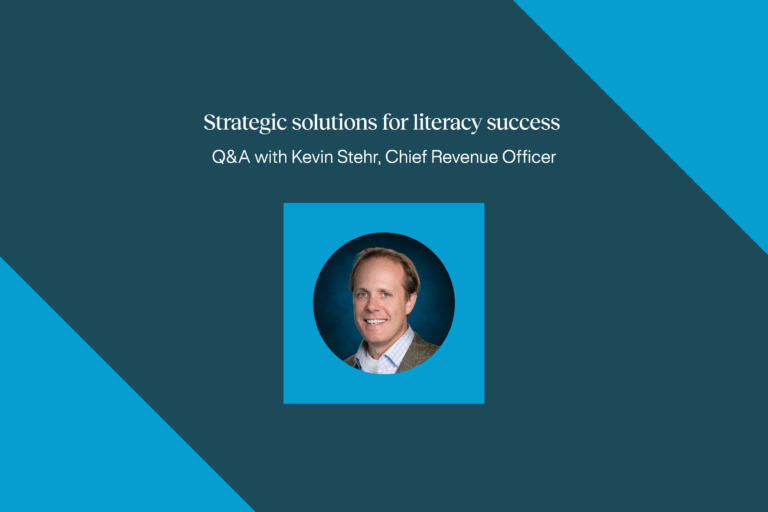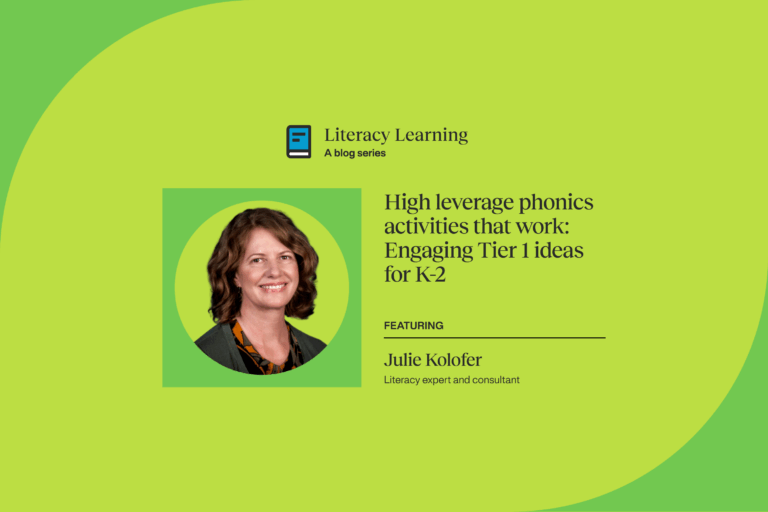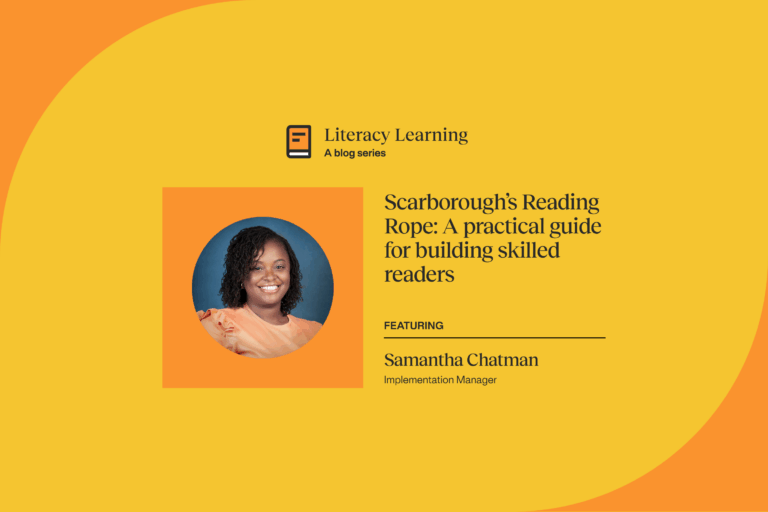Phonics vs phonemic awareness: A complete comparison guide
A post from our Literacy Learning: Science of reading blog series written by teachers, for teachers, this series provides educators with the knowledge and best practices needed to sharpen their skills and bring effective science of reading-informed strategies to the classroom.
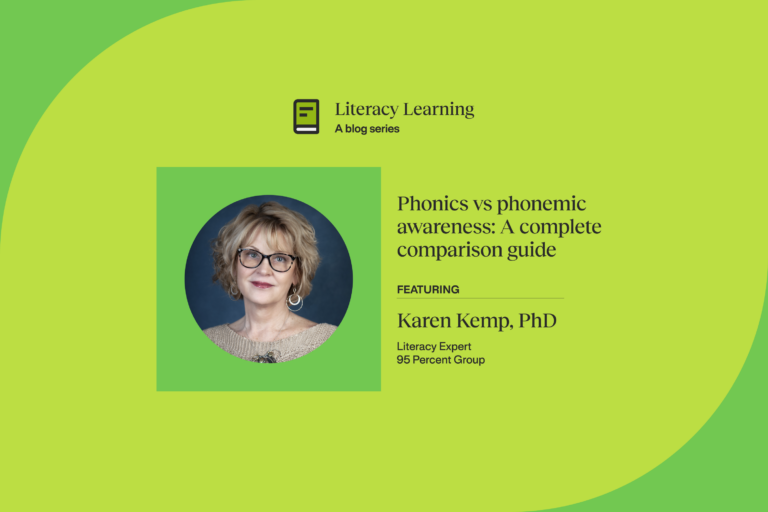
Understanding the key differences and their roles
Learning to read is a complex journey that involves a clear understanding of the relationship between sounds and symbols. For educators, parents, and literacy specialists, grasping the nuances of phonics and phonemic awareness is critical in supporting early reading development. These foundational skills play a pivotal role in helping children decode words, develop strong spelling skills, understand language, and become confident, lifelong readers.
Phonics and phonemic awareness are two foundational components of early literacy. Scarborough’s Reading Rope illustrates the way these two strands are part of reading instruction. They are separate concepts, but woven together in order to support letter-sound correspondence and word reading (decoding).
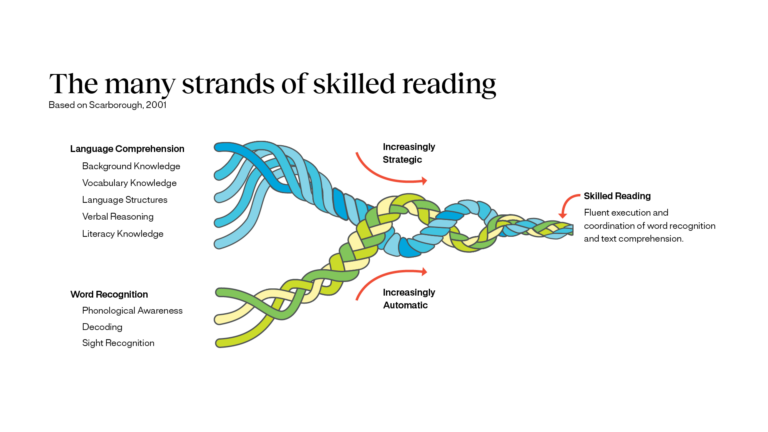
While sometimes there is confusion about whether they overlap, or if one is more important than other, the truth is that children need a strong foundation in both in order to reach the ultimate goal of deep reading comprehension.
Phonemic awareness is closely tied to reading growth and achievement—making it a critical skill for early literacy development.
Karen Kemp, PhD
What is phonemic awareness?

Terms to know:
Phonological processing: is the overall cognitive ability to use the sounds of language to process spoken and written words, including phonological awareness.
Phonological awareness: is a broad term encompassing the ability to think about and have awareness of sound structures in spoken words. While often used to describe a subset of those sound structures, a more specific term is phonological sensitivity.
Phonological sensitivity: the awareness of the larger, sometimes more easily noticed sound structures in speech, including whole words and sound structures within words: rhymes, syllables, onsets, and rimes; we do not explicitly teach these skills, rather we can simply use a lot of language production with young children to point out these large language structures within stories and songs, etc.
Phoneme (or phonemic) awareness is defined by the International Dyslexia Association (IDA) as, “the ability to be aware of and consciously think about the individual speech sounds in spoken words.”
Phonemic awareness is a subskill of phonological processing. It can sometimes feel like an abstract concept for educators to teach—as described by literacy expert Mark Seidenberg—“it’s an almost elusive concept that focuses on the intricate sounds within language.”
Phoneme awareness should be explicitly taught and, according to the most recent research, is most effective when “instruction links phonemes and associated graphemes with letter names and handwriting instruction” (IDA).
It’s important to note that learning to speak is more innate, while learning to read requires understanding symbolic representations of sounds. Author and early childhood literacy expert, Karen Kemp, weighed in on this. “In order for students to understand the writing system, they first have to understand the symbols and the sounds that correspond to those symbols.”
Key aspects of phonemic awareness include:
- Phoneme isolation: initial consonant, final consonant, and medial vowel
- Blending and segmenting phonemes: blending—putting sounds together (/k/-/a/-/t/ → “cat”) and segmenting—separating sounds inside of a word (“cat” → /k/-/a/-/t/)
- Developing phoneme manipulation skills: phoneme addition and deletion and phoneme substitution (“slime” without /s/ → “lime”)
Phoneme awareness involves conscious awareness that allows a learner to notice and think about the phonemes in words they hear and pronounce. This skill develops gradually, almost always in the context of learning about phonemes and letters in written words.
Building Phoneme Awareness: know what matters
What is phonics?
Phonics is the systematic approach to teaching reading by establishing connections between letters (graphemes) and their corresponding sounds (phonemes). It involves understanding letter patterns, positions of graphemes in words, and the ability to assign specific symbols to sounds.
“While some argue that using letter name association in phonemic awareness instruction is the same as phonics instruction” Kemp explained, “there really is a difference. The focus in phonics instruction is on understanding the position of the graphemes or the patterns of the graphemes and using those patterns to decode words.”
Key phonics skills include:
- Developing proficiency in correct grapheme-phoneme correspondence
- Exploring patterns of vowel and consonant positions in words
- Awareness of the 6 syllable types: understanding the position of the vowels and consonants within words
- Repetition and practice of these skills so that decoding becomes automatic
- Multisyllabic word study
Phonics instruction, which according to Kemp requires proficiency in letter-sound knowledge, typically occurs from kindergarten through 2nd grade—with more complex syllable reading introduced in 3rd grade. The goal is to help students decode single-syllable words before progressing to multisyllabic words.
According to Kemp “People sometimes think that phonics instruction is complete after kindergarten and 1st grade—that students are “done” with phonics. But what we now know,” she continued, “is that typically in order to retain all the information, it’s more effective to reserve some of those patterns (vowel teams, etc.) for 2nd grade. Children need explicit phonics instruction that goes beyond 1st grade in order to acquire and become proficient in all of these skills—thus preparing them for the more complex words they will encounter in 3rd grade and beyond.”
Key differences between phonemic awareness and phonics
Phonemic awareness and phonics are two separate and distinct skills among the five components declared essential for learning to read by the National Reading Panel in 2000. Both are critical to teaching children how to read and should be taught explicitly and systematically when children are in kindergarten through 2nd grade.
While closely related, phonics and phonemic awareness have distinct characteristics:
- Focus:
- Phonemic awareness: Concentrates on sound identification and manipulation
- Phonics: Emphasizes phoneme-grapheme relationships and patterns within words to develop word reading skills.
- Skill Development:
- Phonemic awareness: Auditory knowledge of sounds
- Phonics: Visual and auditory skills with letter symbols
- Timing
- Phonemic awareness: Instruction often begins earlier than phonics, although these can and will likely overlap. Some of these skills are developed earlier, often before formal reading instruction.
- Phonics: Structured and explicit instruction typically begins when children enter kindergarten. Phonics instruction is foundational and should continue through at least 3rd grade—with studies now showing that phonics word study instruction is beneficial for 4th and 5th graders as well.
Common Misconceptions
The path to teaching reading has long been a subject of debate in education. Yet the evidence is now unequivocal: decades of scientific research illuminate a clear roadmap for effective literacy instruction rooted in the science of reading. While many schools and districts have embraced this evidence-based approach, persistent myths about phonemic awareness and phonics continue to circulate.
Here are some common myths and misconceptions:
- Myth: Phonemic awareness should be taught without letters or “in the dark.”
Reality: While initial focus can be on sounds, integrating letters as soon as possible enhances learning and helps with reading, writing, and spelling (Brady, S., 2020). - Myth: We need to teach phonological sensitivity skills explicitly to early readers.
Reality: Research tells us that phonological sensitivity (awareness of large structures of language like whole words and sound structures within words: rhymes, syllables, onsets, and rimes) is something that children will pick up if we expose them to a volume of language and point these things out as we encounter them (Brady, S., 2020). - Myth: Teaching phonemic awareness to ELs should only focus on oral activities without connecting to print.
Reality: Integrating letter-sound relationships early on can enhance phonemic awareness development for ELLs.
Integrating phonemic awareness and phonics in the classroom
As students progress through early elementary years, they are acquiring proficiency in foundational phonetic patterns and syllable structures. By third grade, this knowledge crystallizes, enabling them to approach multisyllabic words with confidence.
Karen Kemp, PhD
Whether teaching phonemic awareness or phonics, instruction is most beneficial when explicit, systematic, and based in the science of reading. This means using a structured, deliberate approach during instruction that follows a logical order from simple to complex. Effective literacy instruction involves a multimodal approach:
- Teach letter-sound correspondences comprehensively: Help students connect each phoneme with its representative grapheme.
- Include letter formation, sound production, and mouth positioning: When teaching how to produce each phoneme, show students what the mouth and lip formation looks like and help cue when sounds are “voiced” (/b/, /m/, /g/, etc.) and “unvoiced” (/s/, /p/, /t/) by having them place a hand on their voice box to feel whether it vibrates or not.
- Incorporate handwriting to strengthen phoneme-grapheme connections: model letter formation
- Encourage vocalization during writing and reading: Have students practice writing each letter or grapheme while saying the phoneme aloud.
Looking for more classroom ideas? Check out these blog posts for specific science of reading-based lessons and activities on phonics and phonemic awareness!
Building strong readers: phonics AND phonemic awareness
Understanding phonemic awareness and phonics is crucial for developing strong literacy skills. By recognizing their unique roles and implementing explicit and systematic, multimodal approaches that are grounded in science, educators can support all students in becoming confident, proficient readers.
By providing structured, engaging literacy instruction from kindergarten to grade 5, we can help every child unlock the magic of reading.

Expert Biography
Karen Kemp, Ph.D.
Regional Consultant Manager, 95 Percent Group
Karen Kemp, Ph.D. is a literacy consultant, facilitator, and author with a striking level of depth in her circulation and experience. Dr. Kemp has enjoyed being a kindergarten teacher, secondary inclusion and self-contained teacher, and vocational work-study coordinator before transitioning to administrative roles at the school and district level. She is a certified Critical Friends Coach® and the author of various educational publications including Teach All, Reach All—Elementary and Secondary, RtI: The Classroom Connection to Literacy, RtI & Math, RtI & Literacy laminated guides and Cool Kids: A Proactive Approach to Social Responsibility. Kemp is currently a 95 Percent Group Regional Consultant Manager.
Sources
- Brady, Susan. 2020. “A 2020 Perspective on Research Findings on Alphabetics (Phoneme Awareness and Phonics): Implications for Instruction (Expanded Version).” The Reading League Journal, 20–28. https://www.thereadingleague.org/wp-content/uploads/2020/10/Brady-Expanded-Version-of-Alphabetics-TRLJ.pdf.
- “Building Phoneme Awareness: Know What Matters – International Dyslexia Association.” International Dyslexia Association. December 21, 2022. https://dyslexiaida.org/building-phoneme-awareness-know-what-matters/.
- National Reading Panel. n.d. “Reports of the Subgroups.” https://www.nichd.nih.gov/sites/default/files/publications/pubs/nrp/Documents/report.pdf.
- “English Language Learners and the Five Essential Components of Reading Instruction | Reading Rockets.” https://www.readingrockets.org/topics/english-language-learners/articles/english-language-learners-and-five-essential-components.
